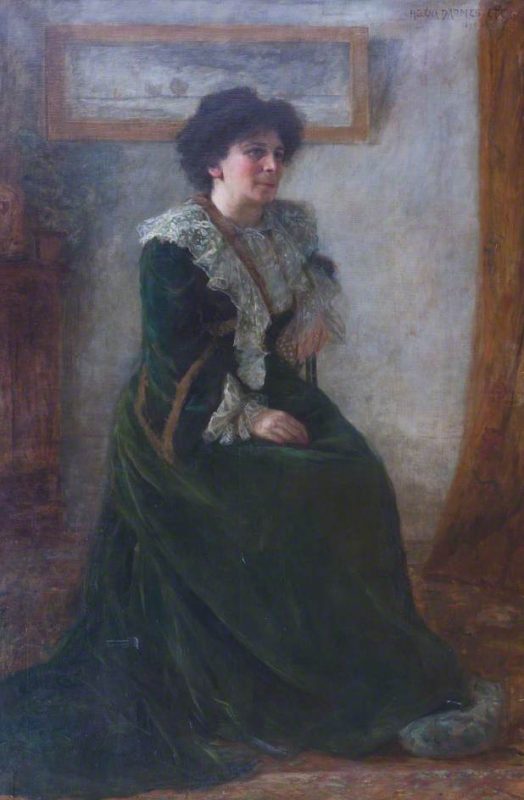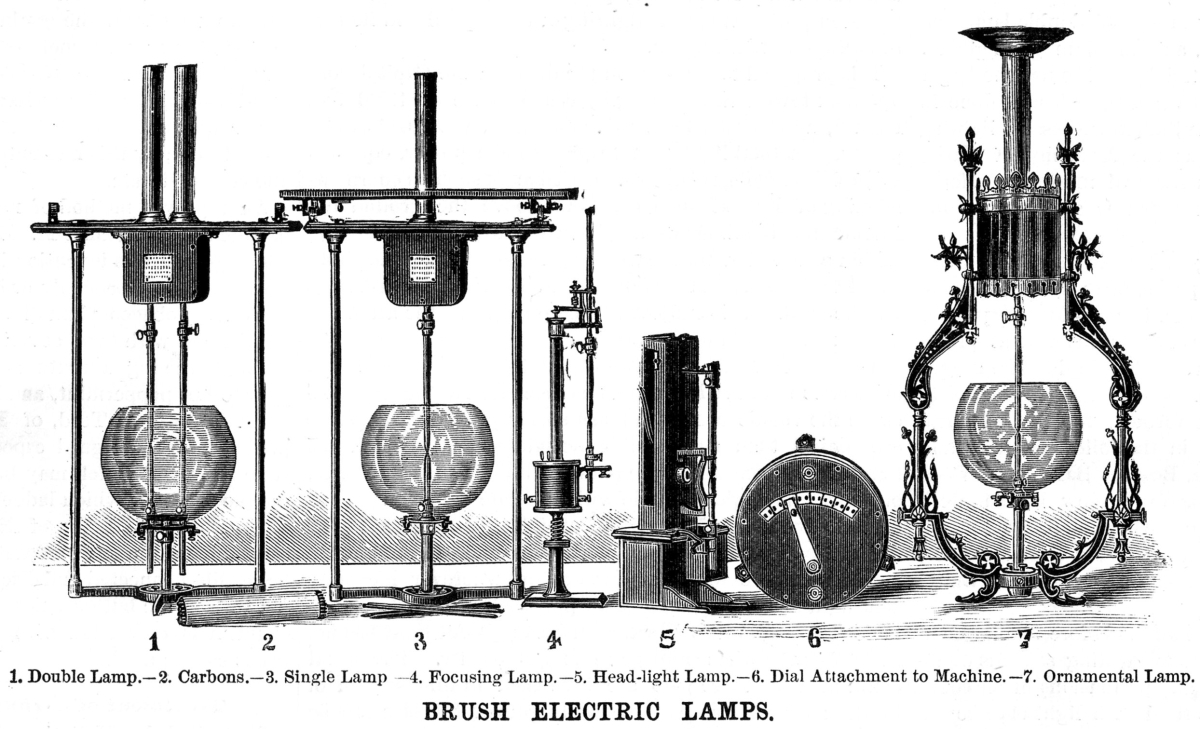By Emily Doucet
A 1905 painted portrait of the decorated scientist and electrical engineer Hertha Ayrton situates her within her home rather than in any of the many public spaces which she regularly took charge. This is not an unusual convention of period portraiture, but given her consistent and formidable occupation of institutional spaces that had previously denied women access, such as the Royal Society and the Institute of Electrical Engineers (now IEE), it is notable that no visual representations of Ayrton show her as she so often was: speaking in public on behalf of science, women, and women in science.
While this may have represented a contradiction in terms for those (usually male) scientists graced with the institutional support of an onsite laboratory, for Ayrton there was no such tension. This portrait reminds us that for Ayrton the spaces meant for “women’s work” were also possible spaces for scientific work.

Born Phoebe Sarah Marks in Portsea, Hampshire, England in 1854, Ayrton was later nicknamed Hertha after a Algernon Swinburne poem titled “Hertha” by her friend and patron Barbara Bodichon, a well-known 19th-century women’s rights activist. Ayrton attended Girton College in Cambridge, the first residential degree-granting college for women. Thanks to financial aid from Bodichon and others, she passed the mathematics tripos at Cambridge in 1880. At that time, Cambridge did not award degrees to women, prompting Ayrton to return to London to receive an external BsC from the University of London. Upon her return to London, Ayrton filed the first of many patents: a line divider employed by artists, architects, and engineers to alter the size of images while maintaining their scale.
Ayrton joined her scientific pursuits with the cause of women’s rights throughout her career. One of the earliest examples of this was the inclusion of her line divider in the Loan Exhibition of Women’s Industries held in Bristol in 1885, organized by suffragist Helen Blackburn. The first of its kind in England, the exhibition took place in the Queen’s Villa in Brighton, using a domestic residence to celebrate women’s contributions to science and industry. As the Clifton Chronicle noted, “To prove women’s capacity for exercising the franchise, probably no better plan could have been devised than to make manifest their intelligence in scientific and artistic pursuits, than by collecting in one building women’s finest productions.”
Throughout her life, Ayrton fused her public feminism with her scientific work, and she was deeply committed to suffrage work, supporting radical suffragists with fiscal donations and shelter as needed and marching and speaking frequently for the cause.
Ayrton went on to study electrical engineering at Finsbury College, where her soon-to-be husband and fellow electrical engineer William Edward Ayrton was one of her professors. After her marriage in 1885, Ayrton established a home laboratory. Remarking on this unusual domestic environment, her daughter Barbara later exclaimed, “I do wish mother had a boudoir, all filled with yellow satin furniture, instead of a laboratory — like the mothers of other girls!” Further collapsing distinctions between domestic space and scientific practice, Ayrton taught classes for women out of her home on the subject of practical and domestic electricity in 1886, which was of great interest in this period. The Star reported on January 18, 1888 that the classes were sensational:
It must have been a revelation to the ordinary person — and her lectures were addressed to the ordinary person — to hear that in the home this still unused force [electricity] might be employed to save labour by driving the sewing machine, cleaning silver, as well as boots and knives, and winding clocks; that “seeing by electricity,” and electrical sound-magnifying were not impossible miracles, and that, indeed, life might altogether be transformed in various ways that at the time of writing are still unrealized in the average home.
In 1891, Ayrton received a small inheritance from Bodichon. This allowed Ayrton the privilege to hire a housekeeper, which gave her more time to devote to her research. Her work in this period focused on experiments with the electric arc lamp, for which she is perhaps best known. Innovating on previous models, she isolated the hissing and flickering effects of unwanted oxygen reaching the carbon rods inside the lamp. Ayrton published a series of 12 articles about the electric arc in the journal The Electrician between 1895 and 1896, later published as a book. These publications garnered the attention of the Institute of Electrical Engineers (IEE), who invited her to become the first woman to read a paper for the association. The IEE elected Ayrton to become a full member on May 25, 1899 — the first such opportunity afforded a woman electrical engineer.
Throughout her life, Ayrton fused her public feminism with her scientific work, and she was deeply committed to suffrage work, supporting radical suffragists with fiscal donations and shelter as needed and marching and speaking frequently for the cause. Ayrton lived to see women gain partial enfranchisement in Britain after the end of the First World War in 1918 (all women over 21 were given the right to vote in 1928). She contributed to the war effort with her invention of the Ayrton anti-gas fan, designed to disperse clouds of poison gas in the Allied trenches. The war would see developments in the alliance of science and suffrage as more women entered STEM fields throughout the years of the war, a union Ayrton had so fully embodied throughout her life.
The portraits and documents of Ayrton’s life and work preserve this union of her feminism and scientific work.
This union between feminism and scientific practice was implicitly acknowledged in another portrait of Ayrton. A photograph titled “Mrs. Ayrton in her Laboratory” shows Ayrton in her home laboratory behind a ripple tank, which was used in her research into water vortices and sand ripples. The photograph distinctly places Ayrton with her research tools within a domestic space. Above the bookshelf behind Ayrton there is a print of a painting by Joseph Wright of Derby, entitled A Philosopher Giving a Lecture on the Orrery in which a Lamp is Put in Place of the Sun. Formally echoing the placement of the male natural philosopher or scientist expounding on the workings of the universe, Ayrton is positioned as a figure of authority on those objects displayed in front of her. She won the prestigious Hughes Medal from the Royal Society in 1906 based on her research, likely the reason for this photograph. Despite being the recipient of a prize from the institution, and one of the first women to read a paper before the society, Ayrton’s application for membership to the Royal Society had previously been declined on the grounds that she was a married woman.
The Scottish chemist Sir William Ramsay commented on the announcement of the medal, saying, “all the eminent women scientists have achieved their best work when collaborating with a male colleague.” She would not tolerate such aspersions on her talents. Ayrton knew the power of the press to make or break a scientist’s reputation, and she characteristically seized the last word:
As far as I am concerned, Sir William Ramsay is even more at fault, for all my scientific work has been carried out alone. My husband foresaw that if we collaborated any merit that might attach to our work would be attributed to him...and he therefore, out of a chivalrous regard for my scientific reputation, refused ever to collaborate with me...In later days, he knew so little of what I was doing on the subject of sand ripples and oscillating water that he saw some of my experiments for the first time when I showed them in public.
The separation of her research space from that of her husband no doubt gave Ayrton the ability to so firmly create this neat division — a fate not allowed her friend and fellow scientist Marie Curie. In 1909, the Westminster Gazette had claimed that Pierre Curie had discovered radium independently of his wife. Ayrton defended Marie Curie’s work in a letter to the Westminster Gazette, famously writing that, “Errors are notoriously hard to kill, but an error that ascribes to a man what was actually the work of a woman has more lives than a cat.” Ayrton was focused on the historical record, specifically as it pertained to women and science.
The portraits and documents of Ayrton’s life and work preserve this union of her feminism and scientific work. If early in her life her daughter wished her mother was more like other mothers in their preferences for boudoirs over laboratories, this was certainly not the case by adulthood. A militant suffragette, Ayrton’s daughter Barbara carried on her mother’s politics supporting women’s rights and eventually serving as a Labour MP in the House of Parliament. In this personal legacy and in her numerous inventions and discoveries, we can see the ways in which marrying the spaces of home and laboratory further permitted Ayrton to make significant contributions as both an engineer and a feminist, roles which were not necessarily complementary in engineering at the turn of the 20th century.
Further reading
Elizabeth Bruton. “The life and material culture of Hertha Marks Ayrton (1854–1923): suffragette, physicist, mathematician and inventor.” Science Museum Group Journal 10 (Autumn 2018).
Claire G. Jones. Femininity, Mathematics and Science, 1880-1914 (Palgrave Macmillan, 2009).
Patricia Para. A Lab of One’s Own: Science and Suffrage in the First World War (Oxford: Oxford University Press, 2018).
Evelyn Sharp. Hertha Ayrton 1854-1923: a memoir (London, Edward Arnold & Co., 1926).
Emily Doucet is a writer and PhD candidate in Art History at the University of Toronto. Her current research explores the visual culture of technology throughout the 19th century.
*Correction: A previous version incorrectly stated IEEE as the abbreviation for the Institute of Electrical Engineers. It has been updated with the correct abbreviation, IEE.
Lady Science is an independent magazine that focuses on the history of women and gender in science, technology, and medicine and provides an accessible and inclusive platform for writing about women on the web. For more articles, information on pitching, and to subscribe to our newsletter, visit ladyscience.com.
